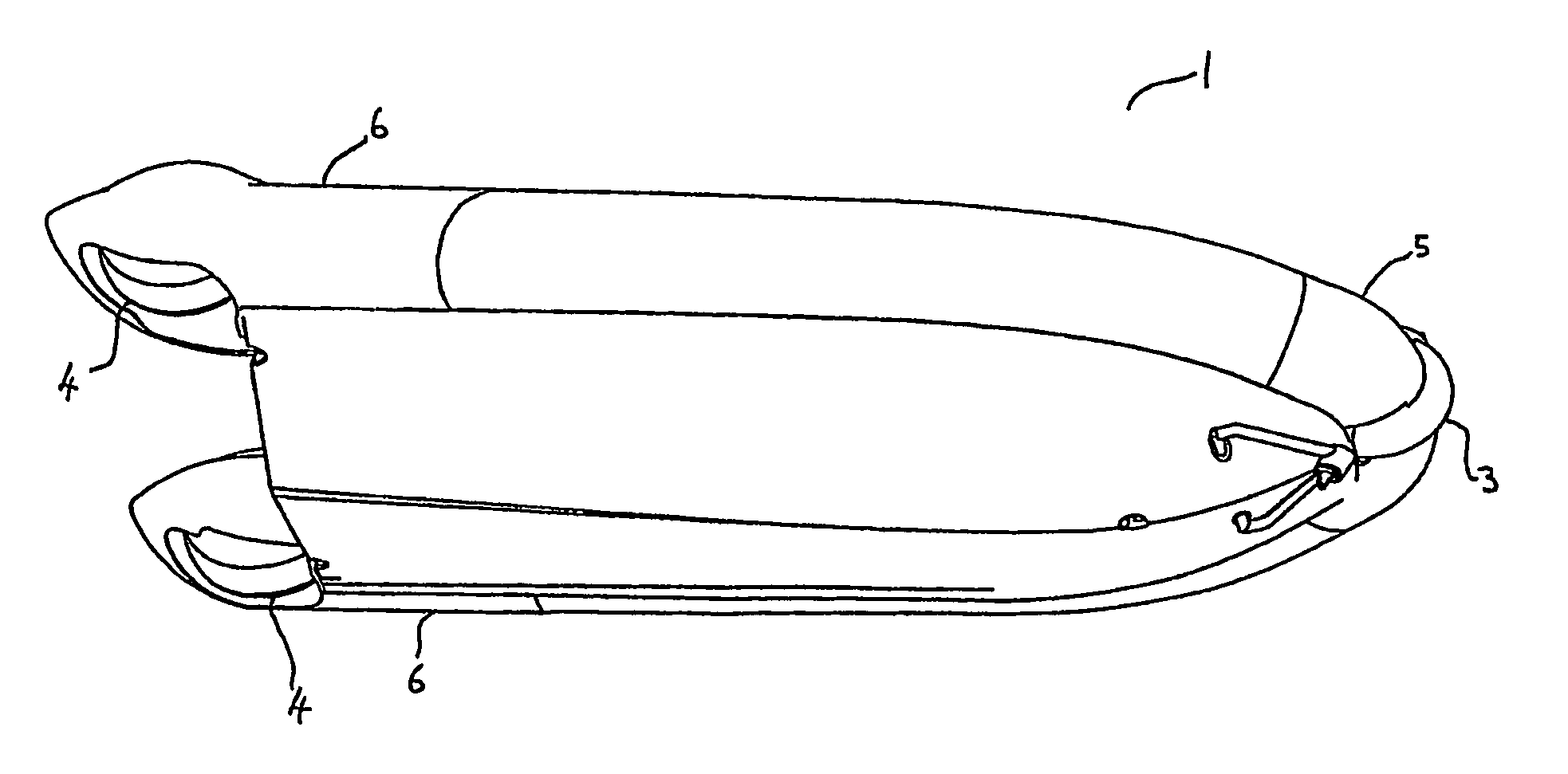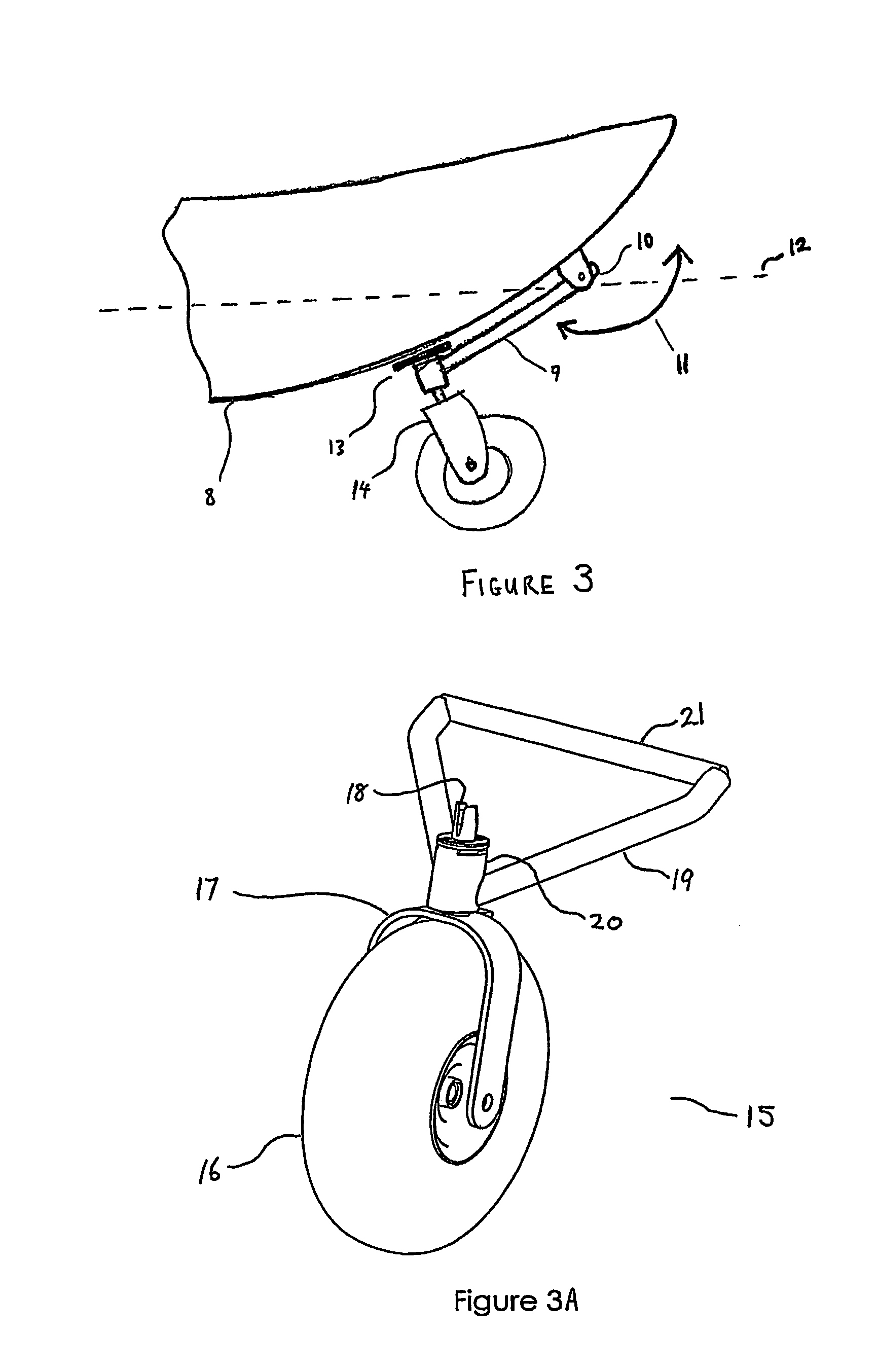Amphibious vehicle
a technology for amphibious vehicles and vehicles, applied in the field of amphibious vehicles, can solve the problems of beaching a boat or jet ski, difficulty similar to the one encountered by users of small to medium-sized boats, and difficulty in overcoming obstacles
- Summary
- Abstract
- Description
- Claims
- Application Information
AI Technical Summary
Benefits of technology
Problems solved by technology
Method used
Image
Examples
first example
1.0 FIRST EXAMPLE
An Inflatable Craft
[0184]FIG. 1 shows a first preferred embodiment of the amphibious vehicle 1, comprising an inflatable craft 2, fitted with a single nose undercarriage assembly 3 and two aft undercarriage assemblies 4, providing means for the craft to travel over land. Fibreglass cowlings are provided towards the front of the craft and towards the rear 6. The cowlings are shaped to conform to the lines of the inflated tubes 7. The leg assemblies are structurally attached to the hull 8 of the craft. A primary structure is any structure, the failure of which will impair the safety of the vehicle when operating within its design envelope, for example but not limited to, the hull or hulls, any keel beam structure, transverse frames, main bulkheads and / or chassis.
[0185]FIG. 2 shows the same craft 1 with the undercarriage assemblies 3&4 retracted and stowed within the cowlings 5&6, as they would be during the predominant use of the craft as a water-borne vessel.
[0186]1....
second example
2.0 SECOND EXAMPLE
Jet Boat
[0238]2.1 Nose gear—similar to that described in Example 1 above, refer to paragraph 1.1.
[0239]2.2 Steering—similar to that described in Example 1 above, refer to paragraph 1.2
[0240]2.3 Aft gear—similar to that described in Example 1 above, refer to paragraph 1.3, except that shorter legs may be used since no external propeller requires protection during ground operations.
[0241]2.4 Stowage of legs and wheels—substantially within the existing lines of the craft as with the inflatable craft described in Example 1 above, except that the cowlings 5&6 will match the contours of the rigid hull
[0242]2.5 Motive power—similar to that described in Example 1 above, refer to paragraph 1.5. It is preferable in this case to utilise the existing marine engine 85, including the adaptations required for cooling and sound muffling.
[0243]2.6 Drive train—similar to that described in Example 1 above, refer to paragraph 1.6.
[0244]2.7 Braling—similar to that described in Example ...
third example
3.0 THIRD EXAMPLE
Outboard Powered Rigid Hull Craft
[0245]3.1 Nose gear—similar to that described in Example 1 above, refer to paragraph 1.1.
[0246]3.2 Steering—similar to that described in Example 1 above, refer to paragraph 1.2.
[0247]3.3 Aft gear—similar to that described in Example 1 above, refer to paragraph 1.3.
[0248]3.4 Stowage of legs and wheels—similar to that described in Example 2 above, refer to paragraph 2.4.
[0249]3.5 Motive power—similar to that described in Example 1 above, refer to paragraph 1.5.
[0250]3.6 Drive train—similar to that described in Example 1 above, refer to paragraph 1.6.
[0251]3.7 Braking—similar to that described in Example 1 above, refer to paragraph 1.7.
PUM
 Login to View More
Login to View More Abstract
Description
Claims
Application Information
 Login to View More
Login to View More - R&D
- Intellectual Property
- Life Sciences
- Materials
- Tech Scout
- Unparalleled Data Quality
- Higher Quality Content
- 60% Fewer Hallucinations
Browse by: Latest US Patents, China's latest patents, Technical Efficacy Thesaurus, Application Domain, Technology Topic, Popular Technical Reports.
© 2025 PatSnap. All rights reserved.Legal|Privacy policy|Modern Slavery Act Transparency Statement|Sitemap|About US| Contact US: help@patsnap.com



